| |
 |
Seattle |
Washington |
USA |
Vertical Dial |
Dial 745 |
| A 12 x 30 foot vertical dial on a brick wall that declines 0.5? west of south. The 5 foot stainless steel gnomon tip carries a sheet metal sculpture of an eagle, the school mascot. The hour lines are aluminum strips terminating in Arabic hour numerals. The dial face includes ceramic disks painted by school students and are placed so that the gnomon shadow falls on then on their birthday. |
| |
| |
 |
Seattle |
Washington |
USA |
Vertical Dial |
Dial 744 |
| A 10 x 18 foot vertical dial on a south-facing brick wall. The hour lines are stainless steel sheet and are formed to create shadow effects that change with the position of the sun. The stainless steel Arabic hour numerals are on disks that are held on the wall by magnets, allowing them to be placed for ST or DST. A stylized school emblem is placed at the base of the gnomon. A round, two-sided plaque in the wall below describes the use of the dial, designed by Mindy Cameron of Lehrman Cameron Studio. |
| |
| |
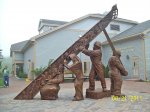 |
Saint John |
New Brunswick |
Canada |
Horizontal Dial |
Dial 743 |
| A large horizontal dial whose cast metal gnomon is a sculpture commemorating the Canadian National Day of Mourning. The gnomon is supported by statues representing toiling laborers. The surrounding brick courtyard includes bricks marked with Roman hour numerals.
The dial sculpture is identified as the Day of Mourning Monument and was dedicated on the Canadian National Day of Mourning, April 28, honoring those workers in Canada who have been killed, injured or disabled on the job. |
| |
| |
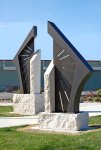 |
Pocatello |
Idaho |
USA |
Vertical Dial |
Dial 742 |
| A south-facing vertical dial split into two sculptures separated by a walking path. The dial faces are vertical powder coated steel sculptures with cut hour lines. The gnomons are travertine limestone blocks with the top edges pointing to celestial north. The edges of the gnomon stones cast the shadow onto the vertical dial faces. One dial face shows the morning hours, the other shows the afternoon hours. The gnomon styles extend to both sides of each dial face allowing extended time and season use.
This sculpture, "PASSAGE OF TIME," was commissioned by the City of Pocatello to represent Pocatello as the "Gate City," historically known as the gateway to the Snake River Plains. The meandering sidewalk path represents passage through both time and space. |
| |
| |
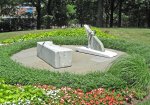 |
Philadelphia |
Pennsylvania |
USA |
Equatorial Dial |
Dial 741 |
| An equatorial projection dial with a 12 inch diameter stainless steel equatorial ring incised with Arabic hour numerals that project onto a grooved central support shaft of Cipollino and Carrara marble set on a bluestone foundation.
A hole near the top of the central marble shaft emits flowing water that runs down the central groove and is recirculated in the warm months. The sundial/fountain marble shaft is 7 inches wide, 36 inches high with a 24 by 55 inch wide base. The dial and nearby Cipollino marble bench rest on a 13-1/2 foot diameter foundation of bluestone pavers set on concrete.
Direct sunlight on the dial is limited by two of the three nearby buildings. In summer with a high elevation sun, sunlight casts gnomon shadows mid-day and for a few hours in the afternoon.
The sundial/fountain sculpture was commissioned by Society Hill Towers in honor of I. M. Pei, Architect of the Towers and was dedicated on the 40th anniversary of the Towers in 2003. |
| |
| |
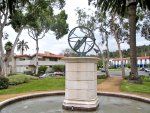 |
Palos Verdes Estates |
California |
USA |
Armillary Sphere |
Dial 740 |
| A 1.5 meter diameter bronze armillary sphere atop a beige stone pedestal at the center of a 9 meter diameter pond or fountain. The Armillary includes meridian, equatorial and horizon rings as well as Arctic and Antarctic circles. The equatorial ring is perforated with Roman hour numerals and Zodiacal symbols. The central gnomon rod has a ball at the north end and an arrow tail at the south end. |
| |
| |
 |
Ottawa |
Ontario |
Canada |
Sun Alignment |
Dial 739 |
| A memorial alignment dial that illuminates the headstone of the Unknown Soldier on Remembrance Day, November 11 at 11:00 AM, commemorating the end of World War I. Remembrance Day is celebrated on the 11th hour of the 11th day of the 11th month of each year. |
| |
| |
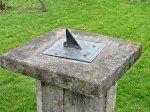 |
Oak Bay |
British Columbia |
Canada |
Horizontal Dial |
Dial 738 |
| A 10 inch square brass or bronze horizontal dial atop a 22 inch square concrete base with cross-shaped plinth 42 inches high. The natural patina developed by the corrosive sea air has reduced the contrast of the markings. Stylized Arabic hour numerals are engraved in circles. Engraved scrolls add interest but some confusion to the dial face. The dial face and gnomon are only one-eighth inch thick but remain intact. |
| |
| |
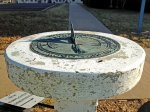 |
North Little Rock |
Arkansas |
USA |
Horizontal Dial |
Dial 737 |
| A cast bronze horizontal dial atop a concrete pedestal. The dial face includes hour lines, quarter hour marks and Roman hour numerals.
The dial face includes inscribed (not in original casting) lines that indicate the sunrise and sunset times for the longest day (L-Day VI-21), shortest day (S-Day XII-21) and equinoxes (12-H Day IX-21). |
| |
| |
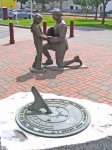 |
Langford |
British Columbia |
Canada |
Horizontal Dial |
Dial 736 |
| A cast bronze horizontal dial with thick bronze gnomon. Dial face shows hour lines and quarter-hour marks, and Roman hour numerals. Dial center includes a compass rose. |
| |
| |
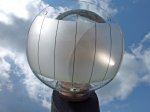 |
Tucson |
Arizona |
USA |
Globe or Hemispheric |
Dial 735 |
| A fused silica glass spherical lens projects a solar image spot onto the inner surface of a spherical segment of glass with a frosted area inscribed with hour lines and Arabic hour numerals. Time is read from the bright spot of light on the frosted surface while standing under the dial. Dial is mounted atop a pipe pillar on the patio of the Visitor Center. |
| |
| |
 |
Carlsbad |
California |
USA |
Vertical Dial |
Dial 734 |
| A large vertical dial on an east-declining south stucco wall of an elevator tower in the parking lot of McClellan Airport. The gnomon, hour and declination lines and Arabic numerals are stainless steel. The dial design is flawed, incorrect for either a point-in-space nodus dial or a polar-inclined gnomon dial. The installed gnomon is horizontal but if intended to support only a nodus, the location is wrong; the nodus shadow is outside the lower declination line in the photos. The hour lines radiate from the gnomon base as for a polar-inclined gnomon; they should radiate from a point much higher if for a point-in-space nodus. |
| |
| |
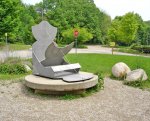 |
Kalamazoo |
Michigan |
USA |
Compound Dial |
Dial 733 |
| A combination horizontal, vertical, polar and equatorial dial 4 x 5 x 6 foot tall made of drilled aluminum plate with rod gnomon. The vertical plate shows the EOT graph and depiction of Earth showing polar tilt, celestial equator and Earth equator using drilled holes. The bottom plate below the equatorial face includes a compass rose that also shows the direction of sunrise and sunset at the solstices. All dial faces are marked using Arabic numerals with hour and 15 minute marks.
The Kalamazoo Nature Center is open most days and charges an admission fee. |
| |
| |
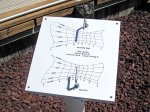 |
Atlantic Beach |
Florida |
USA |
Polar Dial |
Dial 732 |
| A 12 x 12 inch polar dial of printed plastic. Unlike the typical polar dial, this dial uses point-in-space or nodus gnomons. The dial face is aligned in the polar plane; separate face markings and gnomons show summer-to-winter and winter-to-summer hour and date lines corrected for EOT and longitude. Time and date are read from the shadow of only the tip end of each gnomon rod. The three foot high PVC dial support allows the face to be rotated about the polar axis; the face is pointed at the local meridian for ST and rotated 15? east to set for DST.
The face has hour lines for 8 AM to 4 PM and date lines for each month. The hour and date lines were designed for the dial location, median solar declination and the equation of time over a leap year cycle, atmospheric refraction and shadow shortening due to the 90? included angle conical gnomon points. The dial is accurate within two minutes. Dial face is marked with location, coordinates and designer name.
This dial is located within Fleet Landing, a gated retirement community. Please contact Russell Boyd, the dial owner/designer at 904-241-8544 to arrange visiting the dial. |
| |
| |
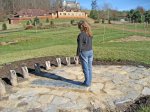 |
Asheville |
North Carolina |
USA |
Analemmatic Dial |
Dial 731 |
| A 16 foot major axis analemmatic dial with stained concrete, hand painted date line. Hemlock branch hour posts were cut by Estate foresters and use iron numerals hand-forged by the Estate blacksmith. |
| |
| |
 |
Stouffville |
Ontario |
Canada |
Vertical Dial |
Dial 730 |
| A 46 inch wide by 52 inch high south-facing vertical dial of high density urethane with a 10 mm diameter stainless steel gnomon. Dial face has hour lines with half-hour marks and Roman numerals. Hour lines are longitude corrected.
A brass plaque containing the dedication, additional information about reading the dial and an equation of time table is mounted on the building wall below the dial. An informative booklet about church sundials is available in the church. |
| |
| |
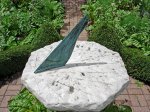 |
Madison |
Wisconsin |
USA |
Horizontal Dial |
Dial 729 |
| An octagonal limestone horizontal dial with bronze gnomon. Hour lines are hand chiseled with no hour numerals. The noon line includes an inset bronze triangle.
Viewing the dial within the garden requires an admission fee. |
| |
| |
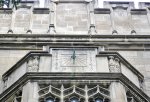 |
Bloomington |
Indiana |
USA |
Vertical Dial |
Dial 728 |
| An approximately 4 foot square, limestone south-facing vertical dial with a bronze gnomon. Dial face has hour lines and half-hour marks with Arabic numerals. Tall trees shade the dial most of the day. |
| |
| |
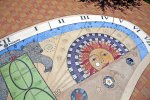 |
Niceville |
Florida |
USA |
Analemmatic Dial |
Dial 727 |
| An interactive analemmatic dial with 6x3 meter major and minor ellipse axes and built of precast concrete, tiles and glass with Roman hour numerals. Dial face markings include Ante Meridiem, Post Meridiem, astronomical symbols for days of week and constellations of the zodiac, compass rose, Sun face, Ursa Major bear constellation with Big Dipper asterism, Polaris solar cell visible at night beneath the noon mark, artistic analemma and artist inscription.
Inspired by the analemmatic dial "Keppel Henge" located at Georgian Bay, Ontario, Canada, the dial was two years in design and construction, with financial support from Ms. Dotty Blacker of Valparaiso, Florida and the NWFSC Foundation. Dial accessories include 8 and 12 foot gnomon poles with leveling clinometers allowing the dial to be used with precision for demonstration and instruction.
The dial is a focal point for geoscience instruction both in the classroom and the local community. The Science Department at NWFSC offers many courses in the geosciences that benefit from the dial, including Earth Science, Physical Science, Physical Geology, Oceanography, and Astronomy; supports baccalaureate programs in Elementary and Middle School Math & Science Education; and is frequent host to a local astronomy club. |
| |
| |
 |
San Ramon |
California |
USA |
Equatorial Dial |
Dial 726 |
| This 5 x 5 x 6.5 foot stainless steel bow-string equatorial sundial is a precise heliochronometer with internal cam mechanism to correct for the Equation of Time. This exceptional dial is made of welded stainless steel sheet and weighs 330 pounds according to the designer Lee Palmer Stephenson. The dial face of the 60 inch diameter equatorial ring is marked with hour, half-hour, 15 minute, 5 minute and one minute lines and Arabic hour numerals showing PST and PDT. |
| |
| |
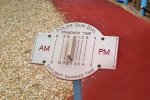 |
Cambridge |
Massachusetts |
USA |
Polar Dial |
Dial 725 |
| A small polar dial with Arabic numerals for EST and EDST |
| |
| |
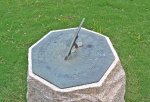 |
Jamestown |
Virginia |
USA |
Horizontal Dial |
Dial 724 |
| A 15 inch octagonal bronze horizontal dial with a bronze gnomon. Dial face shows hour, half-hour, quarter-hour and 5-inute marks with Roman hour numerals. The gnomon is damaged and analysis shows the dial hour lines are laid out for approximately 45° latitude instead of the local 37° latitude. The dial is on a white granite pillar. |
| |
| |
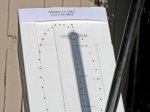 |
Albuquerque |
New Mexico |
USA |
Sun Alignment |
Dial 723 |
| An 8x36 inch polar noon meridian dial of wood and steel pipe. The dial face is inclined at the latitude angle and the shadow-casting 36-inch gnomon pole is perpendicular to the dial face, pointing at the local meridian on the celestial equator. The gnomon pole shadow shows the declination of the sun, with the shadow extending below the gnomon in spring and summer, and above the gnomon in fall and winter. Short rods at the tip of the gnomon cast a cross-shaped shadow on the dial face, marking the date on the nail head analemma on the dial face. At local noon the gnomon shadow is vertical; the face and gnomon size are selected to allow the shadow to always fall on the dial face at noon throughout the year. On the equinoxes, the cross shadow bisects the gnomon base.
This dial is on private property but may be seen from the public sidewalk. For closer inspection, the owner may be contacted. |
| |
| |
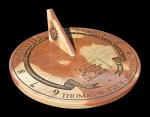 |
Kearney |
Nebraska |
USA |
Horizontal Dial |
Dial 722 |
| A 32 inch diameter bicolored Coconino sandstone horizontal dial with hour, half and quarter hour marks and Arabic hour numerals showing DST with longitude correction. The large noon gap is marked, High Noon. Dial face has carved time ribbon with inlayed brass balls on quarter hours. Gnomon sides show carved sunface and moonface. Dial is placed on a cast concrete pedestal approximately 20 inches high. |
| |
| |
 |
Punta Gorda |
Florida |
USA |
Horizontal Dial |
Dial 721 |
| A monumental sculpture of steel and stone including a 12 foot diameter horizontal dial with six foot high gnomon. Stone dial face includes hour markers and Roman hour numerals. Titled Spirit of Punta Gorda, the sculpture is dedicated to the spirit of the people of Punta Gorda in the aftermath of Hurricane Charlie on August 13, 2004. Two nearby bronze plaques identify and dedicate the sculpture. |
| |
| |
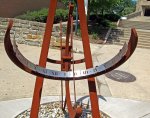 |
Youngstown |
Ohio |
USA |
Equatorial Dial |
Dial 720 |
| A nearly 10 foot high steel equatorial dial with a 30 inch diameter stainless steel hour ring including cut-out diamonds for hour and half-hour marks and Roman hour numerals. The hour ring can be adjusted for EST or EDST and can be set to include longitude correction. The mild steel sculpture has naturally weathered.
Located outside the YSU Ward Beecher Planetarium, the dial is dedicated to the memory of Richard Pirko, long-time planetarium engineer and show producer, whose dream was to have a sundial outside the planetarium. A nearby bronze plaque dedicates the dial. |
| |
| |
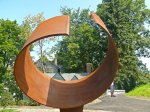 |
Burlington |
Vermont |
USA |
Equatorial Dial |
Dial 719 |
| A 6-1/2 foot tall, 4 foot diameter helical cylinder equatorial dial of self-weathering COR-TEN steel plate. The 2 foot long beveled edges of the two ends of the helix serve as gnomons, casting shadows for standard time and daylight saving time onto the interior surface. Time is indicated by the dominant shadow, top in summer and bottom in winter. Hour marks are shallow bored holes in the interior surface; no numerals are present but the noon mark is indicated by two small adjacent holes. The helical curved edges allow shadows to fall on the interior surface throughout the year as solar declination varies. An adjacent bronze plaque describes the dial and gives an EOT and longitude correction graph. Dial is supported by a curved COR-TEN steel plate allowing some springy motion. |
| |
| |
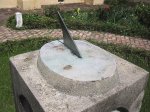 |
Charleston |
South Carolina |
USA |
Horizontal Dial |
Dial 718 |
| A weathered 10 by 15 inch oval marble horizontal dial with bronze gnomon. Dial face has hour lines with Roman numerals showing standard time. Dial sits atop a concrete pedestal with two steps at base. Pedestal has insets on faces, one of which carries a marble plaque with barely readable inscription. |
| |
| |
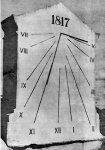 |
Havana |
Havana |
Cuba |
Vertical Dial |
Dial 717 |
| A carved stone, south-facing vertical dial with polar-pointing gnomon, hour lines and Roman hour numerals. The construction date of 1817 is prominently shown at the top of the dial. This is a historic Cuban sundial, known at the "dean of Cuban sundials" and referenced in "This is Cuba, Things of My Country." |
| |
| |
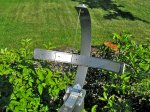 |
Kelowna |
British Columbia |
Canada |
Equatorial Dial |
Dial 716 |
| An approximately 18 inch diameter equatorial dial of brushed aluminum and stainless steel with painted steel equatorial and meridian supports. Hour lines and Arabic hour numerals are marked on dial face and a bow string gnomon is tensioned by the meridian arc, which is adjustable for latitude and provided with a marked scale. Meridian arc is supported on a 3-inch diameter steel pole fixed in concrete. |
| |
| |
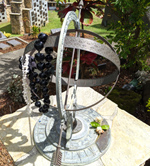 |
Kaneohe |
Hawaii |
USA |
Horizontal Dial |
Dial 715 |
| the original 12 inch diameter bronze horizontal dial has been replaced with a large armillary. The bronze meridian ring is approximately 24-inch in diameter. The equatorial band is about 4-inches wide with Roman numerals marking the hours. The gnomon is a traditional arrow rod. The dial base is approximately 12-inches in diameter with the zodiac names, pictograph, and symbols surrounding the dial. The dial base rests on a square pedestal of mortared stone . |
| |
| |
 |
Nassau Bay |
Texas |
USA |
Horizontal Dial |
Dial 714 |
| A cast concrete horizontal dial with a rugged steel water pipe gnomon. Dial face has hour and half hour marks with Roman hour numerals showing CDST and a compass rose with dial coordinates. A graph marked in the concrete shows EOT correction. |
| |
| |
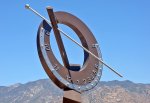 |
Oro Valley |
Arizona |
USA |
Compound Dial |
Dial 713 |
| A massive, 24 foot [7.3m] tall combination almost-vertical and calendrical dial facing southwest so that northeast bound traffic can easily view the dial. The 13 foot [4m] diameter vertical ring dial of welded, zinc-coated steel declines 45 deg west and reclines 12 deg from vertical. The 3 inch [7.6cm] diameter, 20 foot [6m] long polar-pointing gnomon rod is supported in space by a 10 inch [25cm] diameter support tube with a cone nodus on the bottom end. The vertical dial shows longitude-corrected MST with hour and half-hour marks and Arabic numerals on the outer stainless steel chapter ring. |
| |
| |
 |
Bowie |
Maryland |
USA |
Vertical Dial |
Dial 712 |
| The Bowie Portal Dial is a 48x66 inch vertical dial of frosted glass atop two 15 foot tall steel beams. The dial face has bronze filigreed hour lines, Roman hour numerals and a supported bronze gnomon. The translucent glass allows the dial time to be read from both sides. At ground level the two steel beams are surrounded by steel benches covered in granite and form a portal with the silhouette of playing children cut of brass sheet riveted to the stainless steel base. The 11 foot wide base depicts running horses cut in brass and sits atop a 16 foot diameter compass rose. The base includes a plaque with the EOT. |
| |
| |
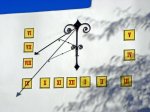 |
Tucson |
Arizona |
USA |
Vertical Dial |
Dial 711 |
| An 84x47 inch vertical dial declining 18? east of south on the outside wall of a private residence. Roman hour numerals are on 8 inch square hand-painted ceramic tiles. The gnomon and support are welded wrought iron painted black. A hand painted EOT graph is shown on a matching ceramic tile.
This is a historic home designed by southwestern architect Josias Joesler. Homeowner found original architectural drawings showing a gnomonically-flawed sundial that was never installed and contacted John Carmichael to design this accurate new dial. |
| |
| |
 |
South Bend |
Indiana |
USA |
Compound Dial |
Dial 710 |
| A combination horizontal dial with nodus on its gnomon and a meridian projection dial located below. Horizontal dial face is 44 inches diameter and made of polished Chinese gabbro basaltic rock, reflecting clouds overhead and gnomon shadow, which shows location of solar noon on gnomonic projection map of the world on dial face. Gnomon is supported by curved triangular bronze arches. Gnomon nodus shadow shows location on map where sun is directly overhead while solstice and equinox lines indicate date. Hour markers show EDST by Roman numerals with ten minute increments by Arabic numerals and marks for one minute. Dial is supported on an octagonal limestone pedestal with French Gothic cathedral window design allowing viewing of meridian dial date line.
Meridian dial is placed below the octagonal limestone pedestal whose French Gothic cathedral window design allows the noon date line to be seen. The date line is illuminated only at noon by sunlight passing through a slit orifice that extends 2/3 the way up the pedestal wall, indicating dates between summer and winter solstice by the end of the end of the bar of light.
The entire combination dial sits on a plaza inlaid with three types of granite to form a 32 foot diameter compass rose, with sunrise and sunset times shown for sixteen dates special to Notre Dame University. |
| |
| |
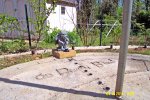 |
Winston-Salem |
North Carolina |
USA |
Analemmatic Dial |
Dial 709 |
| A 23.5 foot major axis analemmatic dial with a 10 foot tall movable steel vertical gnomon. Hours are marked by numerals on solar-powered lamps on the ellipse at the perimeter bush line. The concrete dial face consists of an 8 foot dais that displays the EOT and hosts a handsome gargoyle.
This private dial is available for viewing by contacting the owner. |
| |
| |
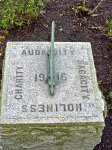 |
Salem |
Oregon |
USA |
Horizontal Dial |
Dial 708 |
| A 14 inch square California granite horizontal dial with a bronze gnomon with hour and half-hour marks and Roman numerals showing PST. Dial face is engraved with the Class Year 1916 and the motto Audacity, Sagacity, Holiness and Charity. The gnomon may have been replaced since originally installed. The dial is atop a gray granite pedestal integral to the dial itself.
The June 8, 1916 Collegian university newspaper provided this: "In presenting the sundial to the university, Walter Gleiser, president of the class, gave a forceful speech in which he portrayed the never-failing accuracy of the instrument's function, believing that it would be of use to the community, and that it should symbolize the good that students of Willamette should be to the world." |
| |
| |
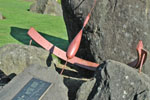 |
Stevenson |
Washington |
USA |
Equatorial Dial |
Dial 707 |
| An approximately four foot diameter equatorial ring dial of natural stone and steel with an analemmic gnomon. Equatorial ring has hour and 15 minute marks with Arabic numeral for PST and PDT. A plaque indicates how to read the shadow of the gnomon, shows primary directions and identifies the dial designer. Plaque includes an analemma showing the equinoxes and solstices and states the dial is accurate within 2 minutes year around. Since the dial includes an analemmic gnomon, no application of EOT correction is needed. |
| |
| |
 |
Savannah |
Georgia |
USA |
Armillary Sphere |
Dial 706 |
| A six foot diameter armillary sphere of steel and bronze with equatorial, meridian, equinoctial colure, ecliptic, Arctic and Antarctic rings. Equatorial ring has Roman hour numerals but no hour marks and includes gold plated Zodiacal symbols on exterior of ring. The sphere base is supported on the backs of cast tortoises atop a 3 foot high square marble pedestal. This dial is located under a heavy canopy of trees and likely never gets direct sunlight today. |
| |
| |
 |
Savannah |
Georgia |
USA |
Horizontal Dial |
Dial 705 |
| A 10 inch round bronze horizontal dial called "The Bull Sundial", sits on an octagonal stone atop a 3 foot high fluted pedestal. The pedestal is in the center of a 10 foot square plaza containing four tile mosaics.. Dial face has Roman numerals, hour lines, five minute marks and a central compass rose. This dial is located under a heavy canopy of trees and likely never gets direct sunlight today, |
| |
| |
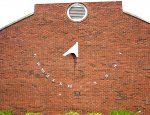 |
New Albany |
Indiana |
USA |
Vertical Dial |
Dial 704 |
| A 15 foot wide vertical dial declining 35 deg east of south on the brick face of a commercial building. Dial face has Roman numerals without hour lines. |
| |
| |
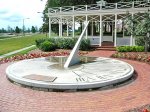 |
Kannapolis |
North Carolina |
USA |
Horizontal Dial |
Dial 703 |
| A large horizontal cast concrete dial on a brick patio. Dial face includes hour lines and Roman numerals. Dial is dedicated as a tribute to the men and women of Kannapolis who died while serving in the US armed forces. |
| |
| |
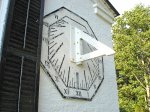 |
Hanover |
Vermont |
USA |
Vertical Dial |
Dial 702 |
| A four foot octagonal dial painted on the south wall of Shattuck Observatory. Dial face has hour lines with 15 minute marks and Roman numerals. Dial need repainting. |
| |
| |
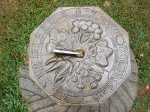 |
Hagerstown |
Maryland |
USA |
Horizontal Dial |
Dial 701 |
| A 16 inch octagonal bronze horizontal dial with hour lines and Arabic numerals. Dial face includes boldly raised representations of five different flowers identified by botanic names. Original gnomon has been replaced. Dial is placed atop an octagonal concrete pedestal with stone base. |
| |
| |
 |
Gettysburg |
Pennsylvania |
USA |
Horizontal Dial |
Dial 700 |
| A hexagonal bronze horizontal dial located on the rear lawn of the Eisenhower National Historical Site. The dial was a gift of the Radio and Television Correspondents Association. Dial face includes hour lines with Roman hour numerals and the inscription Tempus Fugit. The dial and a small plaque are mounted on a 120 mm artillery shell. |
| |
| |
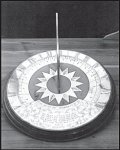 |
Gettysburg |
Pennsylvania |
USA |
Horizontal Dial |
Dial 699 |
| An elaborate gold-colored horizontal dial located on the front lawn of the Eisenhower National Historical Site. The dial was a gift of the National Watch and Clock Collectors. Dial face includes hour lines with Roman hour numerals and a poetic verse describing time. |
| |
| |
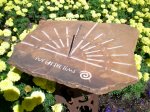 |
Farmington |
Utah |
USA |
Horizontal Dial |
Dial 698 |
| A 20x18 inch sandstone horizontal dial with a 4 inch work-hardened copper gnomon. Dial face has hour lines with Arabic numerals. The hour lines and spiral sun symbol were hand carved using techniques and natural basalt stone tools used to create ancient Native American petroglyphs found in the southwest USA. An ogham character representing the designer's initials is carved in the lower left. Dial is placed on a welded steel pedestal with laser cut images typical of petroglyphs found in Utah. Dial pedestal is welded steel with laser cut images of petroglyphs typical of those in Utah.
Dial is located in the back yard of a private residence. Viewing can be arranged by contacting the owner by email at theoperativemason@gmail.com |
| |
| |
 |
Dundas |
Ontario |
Canada |
Vertical Dial |
Dial 697 |
| A 38 inch diameter porcelain on steel vertical dial declining 14.73 west of east with a nodus on the gnomon using a 7/8-inch diameter brass ball. The dial face shows Arabic hour numerals, solstice and equinox seasonal lines and a solar noon mark at 1:19:51 PM. The dial is corrected for longitude but has no Equation of Time plaque. It is not know why the street was named Sundial Crescent but, living there, the owners wanted a sundial. |
| |
| |
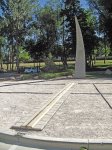 |
Colorado Springs |
Colorado |
USA |
Obelisk or Vertical Gnomon |
Dial 696 |
| A point-in-space or nodus dial with a 65 foot diameter dial face with seasonal markers extending nearly 150 foot wide due to uneven terrain. Time and date are indicated by the shadow of the tip of the 15 foot high curved gnomon. The dial is made of concrete, steel angle, cast iron and Breeze Stone, a compacted crushed stone. Roman hour numerals are cast iron, cast by students at The Colorado Springs School. The dial was designed and built by students, alumni and faculty of the school over a five year period. Provision is made for 60 stone date markers, set to indicate dates of significance to the school calendar. |
| |